Affiliate Disclaimer
As an Amazon Associate I earn from qualifying purchases. It helps me keep the website going. Thank you for your support.
Equestrians will often talk about warm-blooded and thoroughbred horses. But what do these terms mean? And when you compare warmblood vs thoroughbred horses, how do they differ?
Warm blood and thoroughbred horses are different types of horses. But they are also terms referring to different categories. Thoroughbred horses are a particular breed of horse, that belongs to the hot-blooded category. And warm blooded horses are a category that contains quite a large number of different warmblood breeds.
As such, there is only one breed of thoroughbred horse. Whereas, there are many warmblood breeds. That being said, thoroughbreds and warmbloods are both very popular and have their own origin, characteristics, and disciplines.
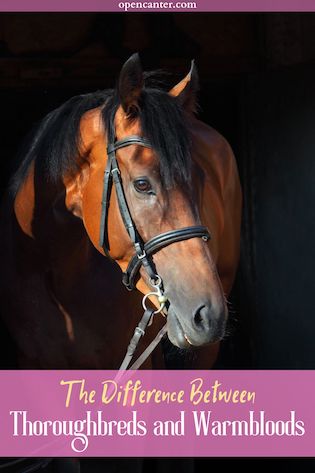
So, let’s take a closer look at the difference between warmblood vs thoroughbred horses.
Warmblood vs Thoroughbred Horses: A Closer Look
From a historical perspective, when comparing warmblood vs thoroughbred horses, the thoroughbred was recognized earlier than the warmblood. So, for that reason, we will start here by looking at the thoroughbred horse first.
Horses existed before humans started categorizing and selectively breeding them. And horses with some of the traits of either thoroughbred or warmbloods lived before humans got involved. However, it was only after humans took an interest in breeding and procuring horses that these terms came into existence.
Before we go on to look at thoroughbreds, it’s a good idea to clarify what is meant by the terms cold blood, warm blood, and hot blood. These terms are vital to understanding some of the differences between warmblood vs thoroughbred horses.
Cold-Bloods, Hot-Bloods, and Warm-Bloods
These terms do not refer to the horse’s body temperature and don’t have anything to do with the horse’s blood type. A cold-blooded horse is most definitely not a reptile!
The term cold, warm, or hot blood, it’s largely a reference to a breed’s temperament.
Cold Bloods
This term is usually applied to draft horse breeds. They are large, heavier horses, with a muscular build and a larger body size. They are typically over 16 hands and weigh in excess of 1400 lbs.
Some cold-blooded breeds include the Clydesdale, the Shire, the Percheron, and the Belgian.
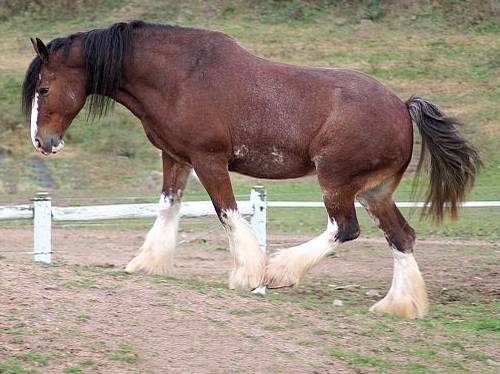
Cold bloods are powerful strong horses, but they are also relatively slow considering the amount of muscle they have. Their relatively slow speed and their calm steady temperament are part of the reason they are referred to as being cold bloods.
Hot Bloods
Hot blood horses are so named because they are often fast, excitable, and sometimes highly strung. Because of their speed and excessive energy, they make good racehorses and are also good for endurance riding.
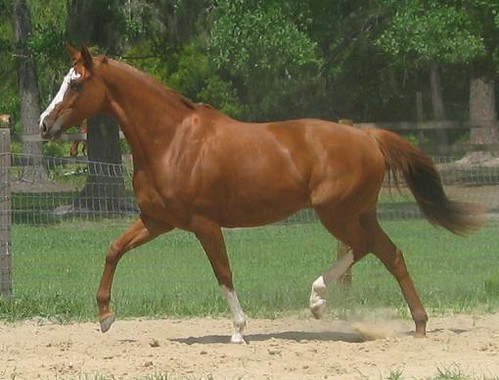
Unlike cold-bloods, hot-blooded horses are light horse breeds like the Thoroughbred, the Quarter Horse, the Arabian, or the Akhal-Teke.
Warm Bloods
It’s often said that warmblood horses are produced by crossing cold-blood and hot-blood horses. This is true, but it’s not the whole picture. And we will go into that in a bit more depth later.
However, generally speaking, it is true that warmblood horses have a temperament that is somewhere between the cold-blooded horse and the hot-blooded horse.
Warmblood horses have some of the power and muscle strength seen in cold-blood horses. But they also have some of the energy and competitive drive seen in hot-blood horses.
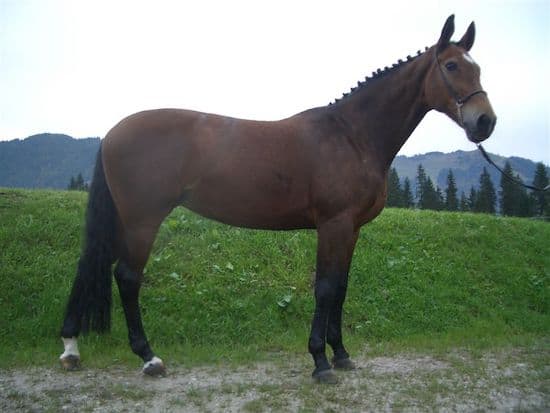
Some warmblood breeds include the Danish warmblood, the Oldenburg, and the Trakehner.
Thoroughbred Horses
There is sometimes disagreement amongst equestrians about which category a breed of horse should be in. However, thoroughbred horses are very firmly in the category of being hot bloods.
Thoroughbreds are lithe, strong, and fast, and as such, they make good racehorses. Over the years, a lot of money and effort has been put into breeding them to bring out those traits.
As a result, thoroughbred horses, are a pure breed and breed more ”true to type” than other horse breeds. A horse is said to breed true when the foal inherits the observable characteristics of its parents.
The purity of the thoroughbred breed is largely to do with its historical origins. So, let’s take a quick look at the fascinating history behind this phenomenal breed.
The Origins of the Thoroughbred vs Warmblood Horses
These days you can see Thoroughbred horses competing around the world. And they have been used to cross-breed with a wide range of horses across the globe. However, as a breed, the Thoroughbred originated in England.
Back in the 16th century, Henry VIII, King of England founded the Royal Paddocks at Hampton Court. Henry and his daughter Elizabeth I imported horses from Europe, in particular Spain and Italy.
They used these European imports to cross-breed with native British horses. This is thought to be the very first beginnings of what became the Thoroughbred breed.
Later monarchs, including Charles I and Charles II, had a passion for horse racing. They continued to work on the breeding of horses for the purpose of producing horses that could race well.
As early as the 17 century, race meetings were being held at towns that are still famous horse racing venues such as Newmarket and Doncaster. Horse racing was already becoming quite an industry by then.
At this point, it wasn’t just royalty who were breeding horses. Wealthy individuals invested money in breeding horses to race. Often they would pay brokers to go abroad and find stallions of good stock to bring back to England for the purposes of breeding.
The last quarter of the 17th century and the beginning of the 18th century was a turning point for the evolution of the Thoroughbred horse.
During this time, a number of stallions were brought to the UK and bred with 43 Mares. These mares, also known as the Royal Mares were originally imported to the UK by James I and were of mixed origins.
The Foundation Horses
Out of the stallions that were imported to the UK around this time, three particular stallions were exceptionally important. Amazingly, these three stallions, along with the Royal Mares, are the horses from which all subsequent thoroughbred horses in the UK have descended.
Here’s a bit of information about each of these three key stallions:
The Byerley Turk
It’s thought that The Byerley Turk was captured by Captain Robert Bryerley around 1686 during the Battle of Buda, in Hungary. The captain brought the stallion to Ireland and rode him again in the Battle of the Boyne in 1690.
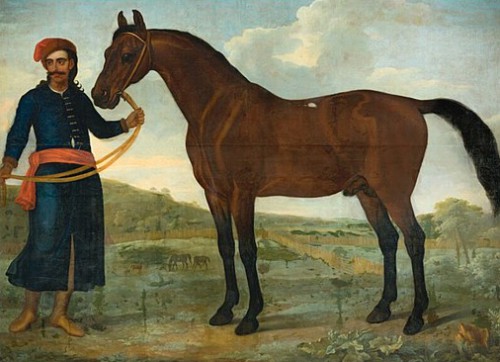
After that, The Byerley Turk was transported to England where he was used to breed. His great, great-grandson, was a horse named Herod. Herod was the foundation sire of what has come to be known as the Herod line in thoroughbred history.
The Darley Arabian
The Darley Arabian, born around 1700, was bought by Thomas Darley, in Aleppo, Syria. He was transported from Aleppo to England by Darley to stand at stud.
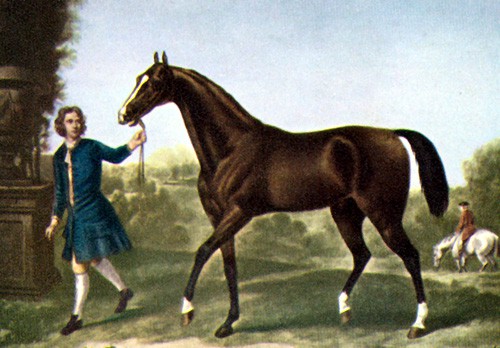
Eclipse, who is considered by some to be one of the greatest racehorses in history was a direct descendant of the Darley Arabian (source). This stallion sired the beginning of what came to be known as the Eclipse line thoroughbred history.
The Godolphin Arabian
The Godolphin Arabian was foaled in Yemen in 1724. He was owned by several riders including royalty on his journey from Yemen to the UK. One of his owners was Lord Godolphin, after whom he is named.
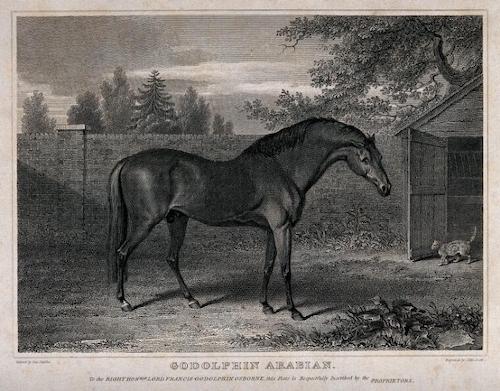
Godolphin owned a stud farm near Newmarket, a famous racing town. The Matchem thoroughbred line descends from the Godolphin Arabian.
Highflyer
The racehorse, Highflyer was foaled in 1774 and was the son of Herod. He was born 10 years later than Eclipse and is considered by many to have been the best racehorse since Eclipse (source). Highflyer was the origin of what came to be known as the Highflyer line.
The Thoroughbred Breed
James Weatherby was a secretary and stakeholder for the UK Jockey Club. In 1791 he published a book called Introduction to a General Study Book. This was revised over the next couple of years, and in 1793, the first volume of the General Stud Book was published.
It is still published every four years by Weatherbys and is a record, of all thoroughbred horses registered in the UK.
The General Stud Book is closed. This means that foals can only be registered in the studbook if both parents are registered thoroughbred horses.
As such, registered thoroughbred horses are pure breeds. You can trace their lineage back through the historical breeding lines documented in the General Stud Book.
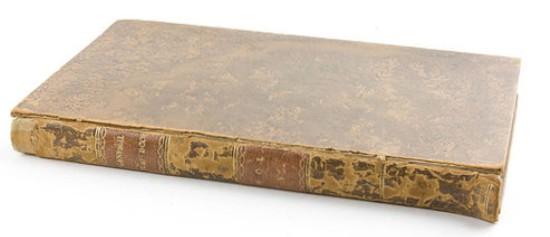
Thoroughbreds Across the World
Although thoroughbreds originated in the UK, they are now bred across the world. There are many thoroughbred breeding programs in different European countries, for example, France, Italy, Germany, Poland, and Hungary. They are also bred in Australia, New Zealand, and America.
The UK studbook is owned by Weatherbys. By contrast, the American studbook is owned and run by the United States Jockey club. The American stud book is also closed, and the history of thoroughbred horses in the US dates back to around 1730.
At that time a stallion named Bulle Rock was transported from the UK to Virginia in the US. Bulle Rock was the son of the Darley Arabian and is thought to be the first thoroughbred horse to have arrived in America.
Over the next few decades, it said that another 186 thoroughbreds were transported from the UK to the US. This is the basis upon which a now burgeoning thoroughbred population in the US began (source).
The Physical Characteristics of the Thoroughbred Horse
The speed, agility, and drive of the thoroughbred horse are down to its physical attributes which include the following:
- Long slim neck: thoroughbreds have long necks which are associated with speed. Short, thick-necked horses are often strong but slow…think of a Clydesdale.
- Sloping shoulders: the angle of a thoroughbred’s scapula gives the horse a well-sloped shoulder. This allows the horse to take long strides. By contrast, a straight shoulder limits the length of the stride.
- Depth through the girth: although thoroughbreds have a relatively short back, their body is deep through the girth. This means that the distance from the top of the back to the belly just behind the shoulder has a good depth.
This is a measurement of the horse’s body capacity. A deep girth means that there is plenty of room for the heart and lungs when they are hard at work during a race. - Strong muscular hindquarters: for good propulsion.
- Clean, hard legs: Typically the legs of a thoroughbred have at least 8 inches of bone below the knee. The research suggests that in the past, the cannon bone on a thoroughbred was longer than this (source).
- An average height of 16 to 16.2 hands: thoroughbreds range from 14.2 hands to 17 hands.
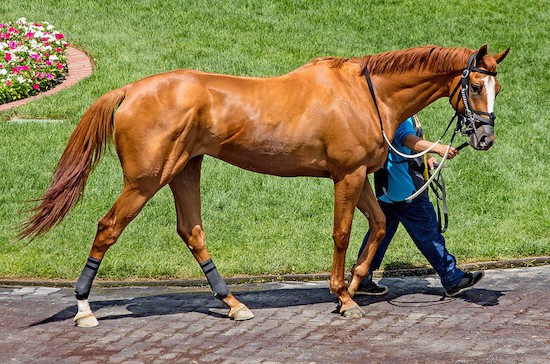
Aesthetic features:
Although the following features are not related to performance or ability, they are typical of the thoroughbred breed.
- Solid colors: Recognized thoroughbred colors include Bay, Chestnut, Brown (dark bay), Gray/Roan, Palomino, Black, or White. They might also have white markings on their legs or face (source).
- A refined head: thoroughbreds are often described as having a refined, intelligent head. Although they are originally of Arabian descent, thoroughbreds do not have a dished face. A dished head is when the horse’s face has a concave profile typical of Arab horses.
Temperament – The Hot-Blooded Thoroughbred
Thoroughbred horses are hard-working and persistent in nature, they quite literally ‘go the extra mile’. They are also known for being intelligent and sensitive.
Whilst sensitivity is an asset in that it means they are aware of themselves and their environment, it can also make them flighty.
Having a sensitive nature combined with the capacity for speed and a lot of energy is why thoroughbred horses are often described as being spirited. This is a polite way of saying that these hot bloods can be highly strung.
For that reason, it’s generally thought that thoroughbred horses are better suited to a more experienced horse rider, rather than a beginner.
Crossbreeding With Thoroughbreds
Although thoroughbreds are a pure breed, they have been crossbred with many other different breeds of horse and pony across the world.
This has enabled other breeds to benefit from some of the best features of the thoroughbred. And it has also led to the development of other horse breeds like the Anglo-Arabian.
Warmblood horses are a good example of this. Many warmblood breeds have been refined through crossbreeding with thoroughbred horses. Let’s take a closer look at warm-blooded horses.
Warmblood Horses
The terminology ‘hot’, ‘cold’, and ‘warm blooded’ suggests that if you simply cross a hot-blooded horse with a cold-blooded horse you will create a warmblood breed. However, this is an oversimplification of what it means to be a warmblood breed.
Warmbloods typically do have a mixture of both cold and hot blood in their ancestral line. But, there are now hundreds of warm blood breeds and many of these are a mixture of other warm bloodlines.
It is most likely that there will be cold and hot blood influence in a particular breed, but it is as likely there will be other warmblood horses in the mix too.
A diverse range of horses is used to cross-breed in the warmblood breeding world. This is because warmblood registries have a different aim than pure Breed registries like the thoroughbred studbook.
For a pure Breed registry, the objective is to preserve and promote the purity of the breed in question. By contrast, the aim of most warmblood studbooks is to develop and improve the athletic ability of the breed.
Because the focus of a warmblood registry is the improvement of sporting ability, they are open to introducing any horse that will boost the breed’s prowess. This might include a cold, hot, or warmblood horse. So, warmblood horses can be a blend of many strands.
Having said that, as stated above, the terms hot cold, and warm refer to temperament and ability. And it is true, that warmbloods do sit somewhere between the extremes of a cold or hot-blooded horse.
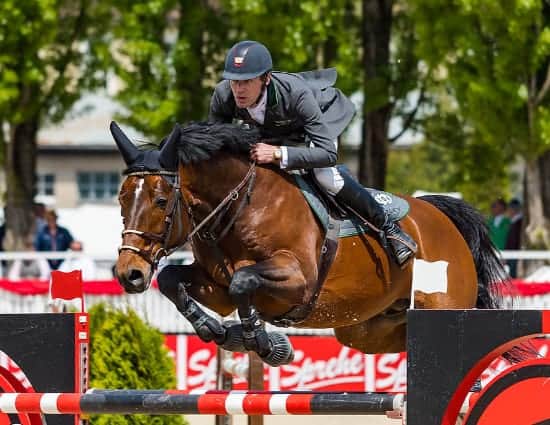
Isiwal, CC BY-SA 4.0, via Wikimedia Commons
For example, warmblood horses are often sporty and fast in a way that cold-blood horses are generally not. Additionally, they are often calmer and less hot-headed than pure breed hot blood horses.
Warmblood Characteristics
Warmblood horses are the most common horses in the world. Thoroughbred horses are also a prolific presence. However, when comparing warmblood vs thoroughbred horses in terms of sheer number, warmbloods have the upper hand.
Because there are so many different breeds of warmblood horse, it’s not possible to give a definitive overview here of the characteristics of each one here. However, it is possible to give a general overview of the warmblood type.
- Sport Horses: These days warmblood horses are specifically bred for modern competitions such as dressage. However, they tend to excel in all sporting arenas including show jumping eventing and carriage driving.
- Middle Weight: warm blood horses are muscular and strong, but they are not heavy and solid like draft horses. But equally, they are more substantial than light horses such as the Thoroughbred, the Pasa Fino, or the Quarter Horse.
So, when comparing the weight of warmblood vs thoroughbred horses, the warmbloods generally come in heavier.
They are typically large horses, with strong bones and solid athletic legs with big hooves. This gives them the capacity to withstand lots of different types of athletic events. - Temperament: generally speaking, warmblood horses are interested in working. They are also energetic and high-spirited without having the same level of nervous energy that you might find in a thoroughbred. In addition to this, they are also often expressive and characterful.

Josette, CC BY-SA 4.0, via Wikimedia Commons
The Origins of Warmblood Horses vs The Thoroughbred
Over the years, warmblood horses have been bred to suit the changing needs of mankind. Before the world became mechanized, most labors were performed manually, and heavy, strong horses were a valuable asset.
An example of this is the heavy draft horse that was used to pull plows in the fields. Or the strong mining horses that were used to drag coal and dirt up from mining pits.
Also, historically, horses were a significant presence in the military and were used during battle and combat. For these horses, strength, and resilience were premium requirements.
However, as the world has changed, the need for very strong draft-type horses has reduced. And the popularity of middleweight sporting horses has increased.
As a result, there has been a huge growth in the number of warmblood horses bred to meet this demand.
Early Warmblood Horses
Because of the large number of warmblood breeds around the globe, it’s not possible to give a complete overview here of the origins of each of these breeds.
However, it’s important to mention that the Trakehner Horse is one of the oldest warmblood breeds. The Trakehner originated from East Prussia (Lithuania), and for that reason is sometimes called the East Prussian Horse.
Stud farms were set up as early as the 13th century by the Knights of the Teutonic Order in East Prussia. However, in 1732 Friedrich Wilhelm I set up the Royal Trakehner Stud Administration.
This was the beginning of an organized breeding program in Prussia. Towards the end of the 18th century, Friedrich’s stud farm was taken over by the State when he died. At that time, many of the inferior horses were removed from the stud farm and new stock was brought in.
Initially, the new stock included the local hardy Schweiken horses. These were small tough horses that had been native to the area since the 5th and 6th centuries BC.
Later on, other breeds were introduced to improve the breeding program. This included Thoroughbreds, Mecklenburg, Danish and Turkish stallions (source).
Over the following years other horses, including English Thoroughbreds and Arabian stallions were introduced to refine the breed. It was at this point that the Trakehner breed was thought to have arrived, and the Trakehner stud book was established in 1878.
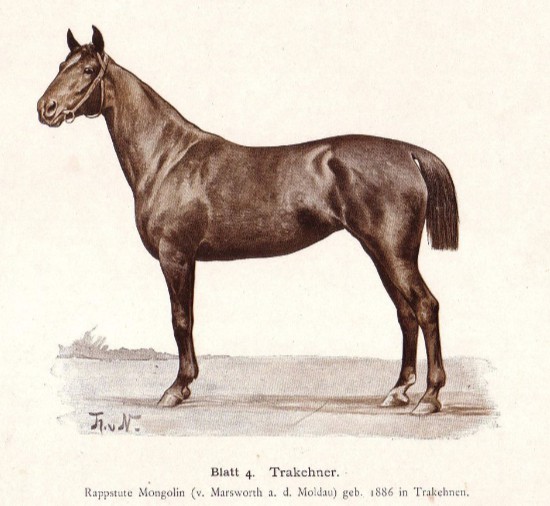
Many countries now have their own population of Trakehner horses, with country-specific stud books.
Modern Breeding of Warmblood Horses
As I touched on earlier on, warmblood horses are now bred to promote their sporting ability. The main criteria to register a purebred horse is that the foal in question descends from parents that are already recognized in the studbook.
By contrast, registering a warmblood horse it’s quite a different process. A warmblood registry will most likely want paperwork to indicate the horse’s parentage. However, often the primary criteria for becoming registered is based on evaluating the foal.
The horse is usually evaluated on their conformation, and their performance whilst they are being put through their paces. Foals may be evaluated at an early age, and then at a later age of around five years of age.
Each studbook will have a different process for application. Some will require the submission of the paperwork to demonstrate the identity of a foal’s sire and dam. However, some will accept horses whose parentage is unknown. These horses are called grade horses.
As well as having different application processes, different registries will also have different objectives. For some registries, their primary purpose is to enhance the performance of the breed as much as possible. As such the priority is on ability rather than the purity of the gene pool.

For the other warmblood registries, part of their objective is to refine the breed sufficiently so that their studbook can become closed. The intention is that at some point the breed will be considered purebred.
Whilst most warmblood registries are open, there are some exceptions to this. One such exception is the American Trakehner Association which is more or less closed.
Warm Blood Breeds
There is an incredible range of warmblood horses each with their own individual attributes and characteristics. Here is a list of just some of those breeds, they are listed alphabetically rather than using any other criteria.
It’s worth mentioning that there is sometimes disagreement over which horses for into the warm blood category. An example of this is the Quarter Horse which is thought by some to be a warm blood, and not so by others. You can read more about whether a Quarter Horse is a warm blood here.
- Appaloosa
- Australian stock horse
- Budenny
- Cheval de selle francais (French saddle horse)
- Danish warmblood
- Don
- Dutch warmblood
- Furioso
- Gelderland
- Hackney
- Haflinger
- Hanoverian
- Holstein
- Irish sport horse
- Kabardin
- Lusitano
- Maremmano
- Missouri fox trotter
- Murgese
- Mustang
- Nonius
- Oldenburg
- Saddlebred
- Standardbred
- Swedish Warmblood
- Tennessee walking horse
- The Cleveland bay
- The Westphalian or Westfalen
- Trakehner
Heavy Warmblood Breeds
I mentioned earlier that warm blood horses are in the middleweight range. However, there are some exceptions, and one significant exception is Heavy warmblood horses.
Heavy warmbloods are considered to be the ancestor of modern middleweight warmbloods. Rather than being a breed in themselves, heavy warmbloods are a group of those breeds that originated in Saxony and Thuringia Germany.
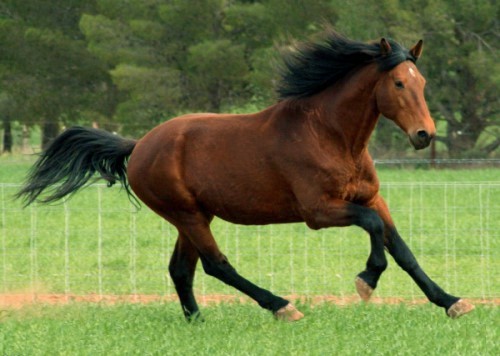
CMSporthorses, CC BY-SA 3.0, via Wikimedia Commons
Some of the breeds included in this group are:
- Cleveland Bay
- East Friesian
- Groningen
- Hungarian Nonius
- Kladruber
- Old-Oldenburger
Heavy Warmbloods were bred originally to be working horses, pulling plows and wagons. They were heavy, and they had strong relatively short legs that were ideal for pulling heavy loads.
It was mentioned earlier that as the world changed and mechanization increased, there is a growing demand for more refined sporting horses. It’s these changes that have led to a decline in the population of Heavy Warmblood horses.
By the 1970s, the breeding of Heavy warmbloods had declined in popularity, and the population what is under threat. However, since then there has been a revival of effort to protect this group.
As a result, many Heavy Warmblood registries are either closed or partially closed. This, in part, is a move towards protecting the different breeds within this category.
Warmblood vs Thoroughbred?- Final Thoughts
On the one hand, comparing warmblood vs thoroughbred horses is a bit like apples and oranges. The thoroughbred is a distinct breed, and warmblood horses are a large group of breeds each with their own distinct qualities.
However, in many ways putting these two types of horses in the same bracket is understandable. They are both athletic, sporty, and fast. I hope this comparison between warmblood vs thoroughbred has been helpful, and that it has helped you tease out some of the differences between the two.




